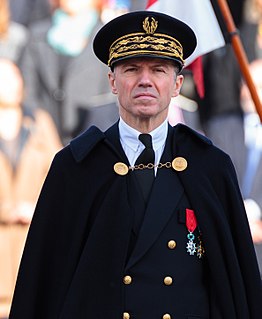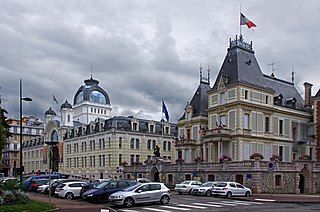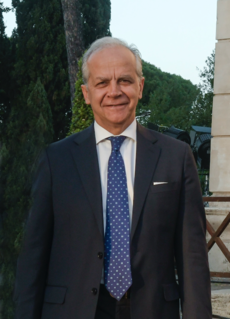A prefecture is an administrative jurisdiction traditionally governed by an appointed prefect. This can be a regional or local government subdivision in various countries, or a subdivision in certain international church structures, as well as in antiquity a Roman district.

In France, a prefecture may be:

Prefect is a magisterial title of varying definition, but essentially refers to the leader of an administrative area.

The Praetorian Guard was a unit of the Imperial Roman army that served as personal bodyguards and intelligence agents for the Roman emperors. During the Roman Republic, the Praetorian Guard were an escort for high-rank political officials and were bodyguards for the senior officers of the Roman legions. In the year 27 BC, after Rome's transition from Republic to Empire, the first emperor of Rome, Augustus, designated the Praetorians as his personal security escort. For three centuries, the guards of the Roman emperor were also known for their palace intrigues, by which influence upon imperial politics the Praetorians could overthrow an emperor, and then proclaim his successor as the new Caesar of Rome. In AD 312, Constantine the Great disbanded the cohortes praetoriae and destroyed their barracks at the Castra Praetoria.
The praetorian prefect was a high office in the Roman Empire. Originating as the commander of the Praetorian Guard, the office gradually acquired extensive legal and administrative functions, with its holders becoming the Emperor's chief aides. Under Constantine I, the office was much reduced in power and transformed into a purely civilian administrative post, while under his successors, territorially-defined praetorian prefectures emerged as the highest-level administrative division of the Empire. The prefects again functioned as the chief ministers of the state, with many laws addressed to them by name. In this role, praetorian prefects continued to be appointed by the Eastern Roman Empire until the reign of Heraclius in the 7th century AD, when wide-ranging reforms reduced their power and converted them to mere overseers of provincial administration. The last traces of the prefecture disappeared in the Byzantine Empire by the 840s.

A prefect in France is the state's representative in a department or region. Subprefects are responsible for the subdivisions of departments, arrondissements. The office of a prefect is known as a prefecture and that of a sub-prefect as a subprefecture.

An apostolic prefect or prefect apostolic is a priest who heads what is known as an apostolic prefecture, a 'pre-diocesan' missionary jurisdiction where the Catholic Church is not yet sufficiently developed to have it made a diocese. Although it usually has an (embryonal) see, it is often not called after such city but rather after a natural or administrative geographical area.

José Saraiva Martins, C.M.F. GCC is a Portuguese Cardinal of the Roman Catholic Church. He was prefect of the Congregation for the Causes of Saints from 1998 to 2008.

Praefectus, often with a further qualification, was the formal title of many, fairly low to high-ranking, military or civil officials in the Roman Empire, whose authority was not embodied in their person but conferred by delegation from a higher authority. They did have some authority in their prefecture such as controlling prisons and in civil administration.

An administrative center is a seat of regional administration or local government, or a county town, or the place where the central administration of a commune is located.

A Roman governor was an official either elected or appointed to be the chief administrator of Roman law throughout one or more of the many provinces constituting the Roman Empire.
The praetorian prefecture was the largest administrative division of the late Roman Empire, above the mid-level dioceses and the low-level provinces. Praetorian prefectures originated in the reign of Constantine I, reaching their more or less final form in the last third of the 4th century and surviving until the 7th century, when the reforms of Heraclius diminished the prefecture's power, and the Muslim conquests forced the Eastern Roman Empire to adopt the new theme system. Elements of the prefecture's administrative apparatus, however, are documented to have survived in the Byzantine Empire until the first half of the 9th century.

A Prefect's Uncle is an early novel by author P. G. Wodehouse, one of his school stories for children. It was first published on 11 September 1903 by A & C Black. An American edition was issued by Macmillan from imported sheets in October 1903.

The praefectus urbanus, also called praefectus urbi or urban prefect in English, was prefect of the city of Rome, and later also of Constantinople. The office originated under the Roman kings, continued during the Republic and Empire, and held high importance in late Antiquity. The office survived the collapse of the Western Roman Empire, and the last urban prefect of Rome, named Iohannes, is attested in 599. In the East, in Constantinople, the office survived until the 13th century.

The cardinal electors in the 1963 papal conclave numbered 82, of whom 80 participated. This papal conclave met from 19 to 21 June 1963. This list is arranged by region and within each alphabetically.

In the Late Roman Empire, usually dated 284 AD to 602 AD, the regional governance district known as the Roman or civil diocese was made up of a grouping of provinces each headed by a Vicarius, who were the representatives of praetorian prefects. There were initially twelve dioceses, rising to fourteen by the end of the 4th century.
A prefect in Romania represents the Government in each of the country's 41 counties, as well as the Municipality of Bucharest.

Patrick Strzoda is a French high-ranking civil servant, a former prefect, and current French President Emmanuel Macron's chief of staff at the Élysée Palace. As President of France, Macron also serves ex officio as one of the two co-princes of Andorra. Strzoda serves as his representative in this capacity.

Pierre Dartout is a French civil servant who has served as Prime Minister of Monaco since 2020 under Prince Albert II. He previously served as a prefect in France from 1997 to 2020. His first posting was in French Guiana. Upon the announcement of his appointment in Monaco, he was in office in Bouches-du-Rhône. Dartout held key positions in the prefecture corps from 1980.

Matteo Piantedosi is an Italian civil servant and politician serving as the minister of the interior in the Meloni Cabinet since 22 October 2022. An independent politician, Piantedosi is close to Lega's leader Matteo Salvini.












